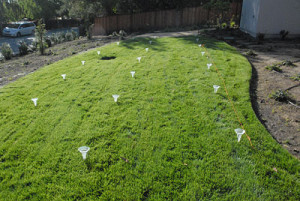Residential Irrigation Water Management Case Study
 In August of 2008, P & P Sprinkler Co. was hired to retrofit the irrigation system for the 37,000 square foot main lawn of a large estate to reduce and eliminate all overspray that had been killing many of the large Palm trees on the property. At the start of this retrofit, we recorded the controller programming and concluded that due to years of having no landscape/irrigation manager on site, the controllers were inappropriately programmed for the different seasons of the year. Because of this, the landscape was receiving almost double its water requirements. This overwatering was detrimental to the health of not only the palm trees but most of the property’s landscape. After obtaining the program information, we conducted a water audit on the main lawn and other parts of the landscape to gather additional information about the irrigation equipment and its efficiency, application rate and the gallons per minute (gpm) for each zone. Based on our findings, we devised a plan that would better manage the water use on the property.
In August of 2008, P & P Sprinkler Co. was hired to retrofit the irrigation system for the 37,000 square foot main lawn of a large estate to reduce and eliminate all overspray that had been killing many of the large Palm trees on the property. At the start of this retrofit, we recorded the controller programming and concluded that due to years of having no landscape/irrigation manager on site, the controllers were inappropriately programmed for the different seasons of the year. Because of this, the landscape was receiving almost double its water requirements. This overwatering was detrimental to the health of not only the palm trees but most of the property’s landscape. After obtaining the program information, we conducted a water audit on the main lawn and other parts of the landscape to gather additional information about the irrigation equipment and its efficiency, application rate and the gallons per minute (gpm) for each zone. Based on our findings, we devised a plan that would better manage the water use on the property.
TESTING The first step included upgrading all four controllers to new “Smart” Controllers with Onsite Weather Monitors that can record real time weather conditions and automatically modify the zone run times to only water what is required for each hydrozone. During installation of the Smart Controllers in February 2009, we input the proper information for each zone in order to conserve water and maintain the health of the landscape. Such information included: sun/shade exposure, soil type and slope of the topography, plant type, sprinkler type, and a base program that acts as a failsafe in case the controller fails to communicate with the weather monitor.
The second step was the installation of a new sub meter for the irrigation system in 2009. This allowed us to monitor the water use for the irrigation system only, separate from the water use in the house. This became a vital tool in determining where most of the water was being used on the property. It was at that time that we began monitoring and managing the property’s water use on a bimonthly basis. This included recording the water meter data and total zone run times for all 96 irrigation zones on the four controllers. Obtaining this information allowed us to determine exactly how much water was being used by each zone. During the first year of routinely monitoring and managing the property’s water use, inputting the proper information into the controllers and allowing the weather monitors to control the irrigation on the property, we were able to reduce the water used by 1,017 billing units (760,716 gallons) -the equivalent of 1.76 feet of water on a professional football field, end zone to end zone.
At the conclusion of the first year of monitoring and managing of the property’s water use, another plan was put into effect; the retrofitting and upgrading of many other zones that had the highest gpm readings and consumed the most water. During 2010, some 40 zones were retrofitted and upgraded with low gpm sprinkler nozzles that increased uniformity of the zone on average of 20%. With the installation of the new high tech low gpm nozzles, we decreased the gpm used among the 40 zones by 47.4%. This was vital to managing the property because it allowed multiple zones to irrigate simultaneously which reduced the length of the irrigation period each run day.
Due to the upgrades completed the second year of our monitoring and management of the property’s water use, we were able to reduce the water used by an additional 1,056 billing units (789,888 gallons); the equivalent of 1.83 feet of water on a professional football field and still maintain the health of the landscape.
With our continued efforts to monitor, manage and upgrade the irrigation system, we have saved roughly 2,073 billing units (1,550,604 gallons) in 2 years, which is the equivalent of standing in a pool of water 3.6 feet deep on a professional football field, end zone to end zone. We achieved a 51.8% reduction in the units of water used for the landscape from March 2009 until March 2011. We are continuing to manage the water use at this site and have consistently lowered the usage year after year since 2008.
